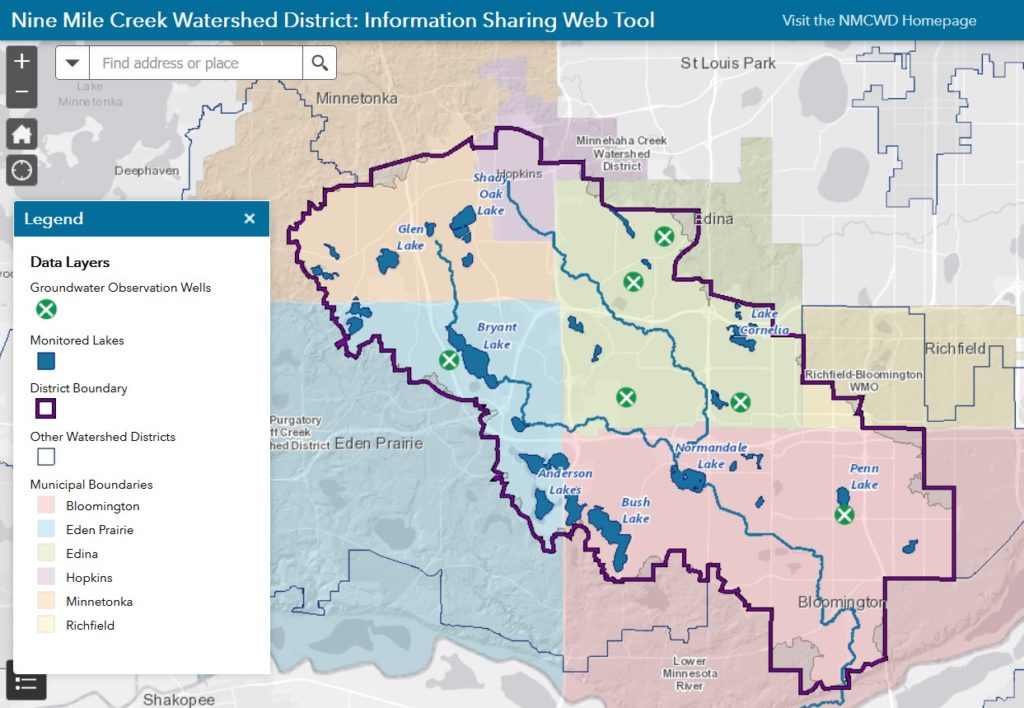The District has a comprehensive monitoring program to evaluate the health of its waterbodies.
Monitoring Program
The District’s lake and stream monitoring program collects water quality data from waterbodies across the watershed. The District monitors the water quality of all of its major lakes on a rotating basis. Samples are typically taken monthly from April to September. The District also has four automated sampling stations on Nine Mile Creek, one of which is operated by the Metropolitan Council.
Data Use
The District uses collected data to understand past and present conditions of our lakes and the creek. The data helps inform the need for action by the District or other entities. Data collected through the monitoring program also allows the District to measure the success of past and/or ongoing implementation projects. Data is also given to other government agencies and the public so they can view water quality changes over time.
View Monitoring Data
The Nine Mile Creek Lake and Groundwater Data Tool provides access to data collected by the Nine Mile Creek Watershed District.
Reports
The District compiles all monitoring data collected in a given year into an annual monitoring report.
2022 Water Quality Monitoring Report (PDF)
2022 Water Quality Monitoring Report Appendices (PDF, 75 MB)
2021 Water Quality Monitoring Report (PDF)
2021 Water Quality Monitoring Report Appendices (PDF)
2020 Water Quality Monitoring Report (PDF)
2020 Water Quality Monitoring Report Appendices (PDF)
2019 Water Quality Monitoring Report (PDF)
2019 Water Quality Monitoring Report Appendices (PDF)
2018 Water Quality Monitoring Report (PDF)
2018 Water Quality Monitoring Report Appendices (PDF)
2017 Water Quality Monitoring Report (PDF)
2016 Water Quality Monitoring Report (PDF)
2015 Water Quality Monitoring Report (PDF)
Additional past monitoring reports are found within our Annual Reports:
Nine Mile Creek 2014 Annual Report (PDF)
Nine Mile Creek 2013 Annual Report (PDF)
Nine Mile Creek 2012 Annual Report (PDF)
The National Weather Service provides a precipitation forecasts specific to the Nine Mile Creek watershed. Get the forecast at: weather.gov/mpx/nmc
Lake Monitoring
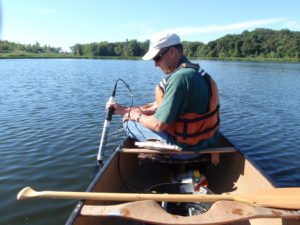
The District’s lake monitoring program provides information and data about the past and present water quality conditions within the watershed. The data collection program is designed to establish baseline water quality conditions, track changes, and inform additional studies. The data that is collected allows the district to measure the success of past and ongoing projects that seek to improve the health of district waterbodies.
Lakes that are currently monitored on a rotating basis by the district are: Anderson (North, Southwest, and Southeast), Arrowhead, Birch Island, Bryant, Bush, Cornelia, Edina, Glen, Indianhead, Lone, Minnetoga, Mirror, Normandale, Penn (Lower), Rose, Shady Oak, Smetana, and Wing.
Lake water quality is determined by analyzing water samples for a range of parameters, including:
- Nutrients (Measured with elements like nitrogen and phosphorus)
- Chlorophyll a (Measures the amount of algae in a water body)
- Chloride (Typically from road salt)
- Field Parameters (e.g., clarity/transparency, temperature, pH, specific conductivity, dissolved oxygen)
Creek Monitoring
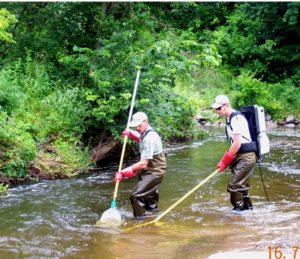
The District monitors Nine Mile Creek to identify problems and any substantial changes in flow, water quality, and the stream’s biological community. The District’s stream monitoring program includes:
- Annual monitoring of the fish community during summer
- Annual macroinvertebrate monitoring during October
- Annual habitat monitoring during the summer
- Storm event related stream water quality monitoring during ice-free season
- March through October monthly measurements of water quality parameters
Data collection occurs at the four permanent, automated sampling stations on Nine Mile Creek. Information is collected on the following parameters:
- Flow
- Precipitation
- Field Parameters (e.g. temperature, pH, specific conductivity, turbidity)
- Chemical water quality, including:
- Dissolved oxygen
- Nutrients
- Chlorides
- Metals
- Solids
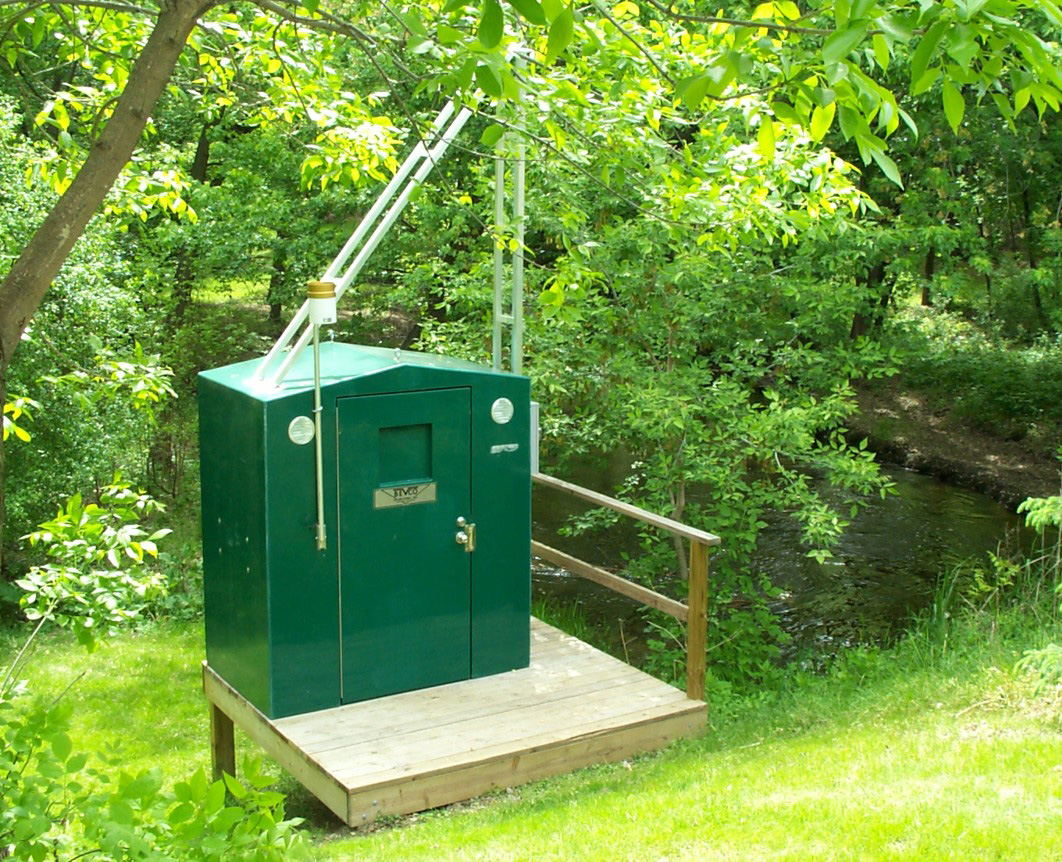 WOMP Station
WOMP StationWHAT IS A WOMP STATION?
WOMP stands for Watershed Outlet Monitoring Program. WOMP stations collect continuous monitoring data year-round. The Metropolitan Council maintains one WOMP station on Nine Mile Creek, while the District operates three sampling stations on the creek.
Groundwater Monitoring
The District monitors groundwater, including the collection of groundwater levels. The District summarizes the data annually and provides the data to the appropriate state agencies. The District will also work with other entities to identify and fill data gaps, including seeking opportunities to increase understanding of groundwater-surface water interaction and understand the impacts of infiltration best management practices on groundwater resources.
How Can You Help?
Various volunteer opportunities are available for people wanting to help protect water quality in the District.
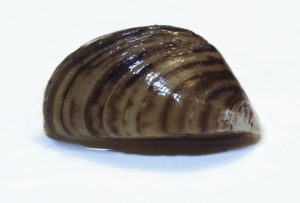
Adopt a Dock
The District has an Adopt a Dock program for residents with lakefront property that helps detect aquatic invasive species. Dock owners install a zebra mussel detection plate at the end of their dock, and check it once a month for zebra mussels. If a possible zebra mussel is found, District staff will come out to verify the sample, then report it to the Minnesota Department of Natural Resources.
Citizen Assisted Monitoring Program (CAMP)
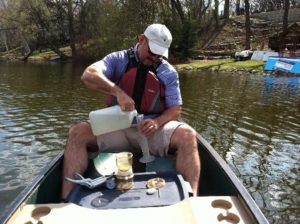
Volunteers in the CAMP program monitor the health of a lake within the District. Water samples are collected by boat twice a month from April through October. The data is used to see water quality trends and make lake management decisions. Training and equipment are provided.
Volunteers must:
- Attend a one-hour training
- Have access to a boat
- Collect bi-weekly water samples
Citizen Lake Monitoring Program (CLMP)
Volunteers in Citizen Lake Monitoring Program (CLMP) the measure water clarity twice a month using a Secchi disk. This program of the Minnesota Pollution Control Agency (MPCA) is less intensive than CAMP, and volunteers coordinate directly with the MPCA. For more information or to volunteer, visit: http://www.pca.state.mn.us/water/become-citizen-water-monitor
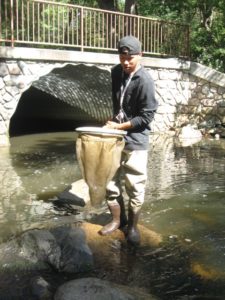
Riverwatch
River Watch is a hands-on environmental education program for youth. Groups assess the health of Nine Mile Creek by identifying and quantifying the stream’s biological community. Youth collect macroinvertebrates (small aquatic organisms) from the creek and then identify them in a lab setting. The program is available to school classes and youth groups.
For more information about these volunteer opportunities contact:
Gael Zembal at 952-204-9691 or gzembal@ninemilecreek.org

